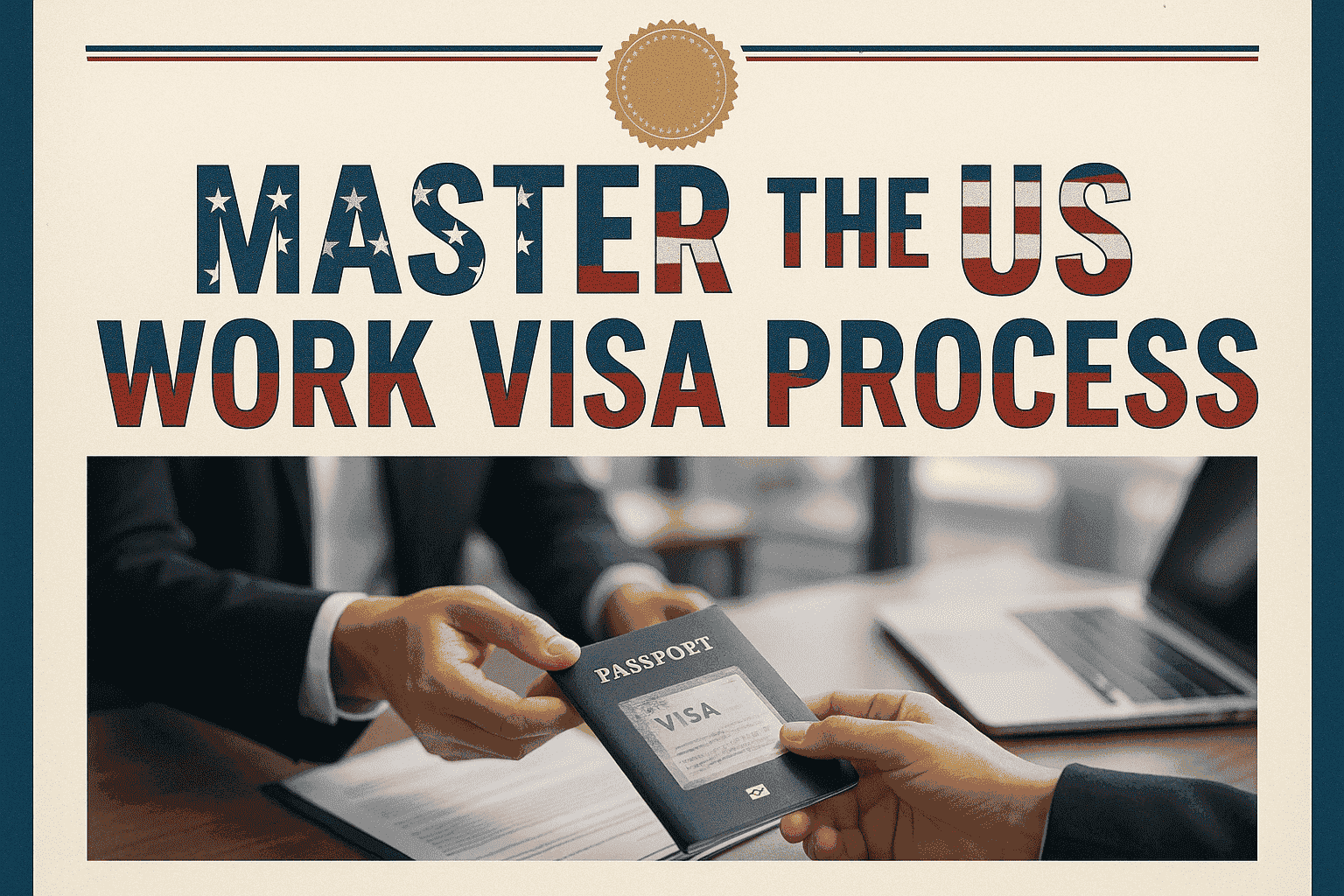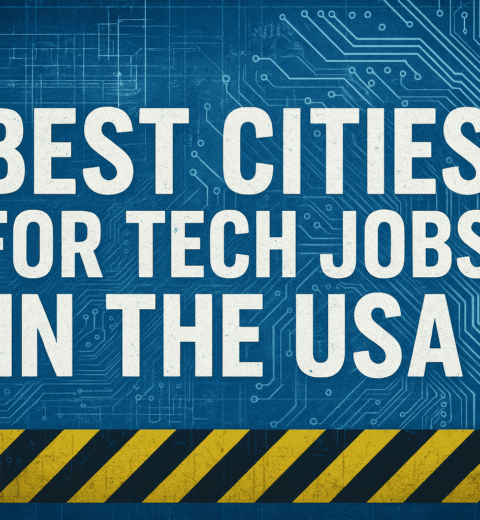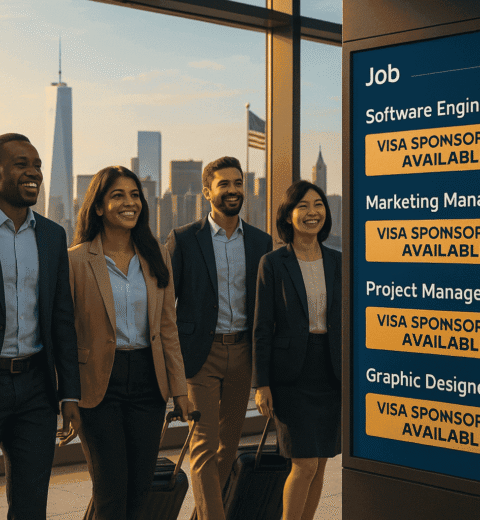Complete Guide to Getting a Work Visa for Jobs in the USA
Table of Contents
Introduction
For ambitious professionals around the world, landing jobs in the USA represents a life-changing opportunity. The American job market is a global powerhouse, offering competitive salaries, cutting-edge industries, and unparalleled career growth—especially in booming sectors like technology, healthcare, and finance. However, obtaining a work visa is a necessary step that you must successfully complete before beginning your ideal employment in the United States.
The U.S. work visa process can seem overwhelming, with different visa categories, strict eligibility requirements, and ever-changing immigration policies. But don’t let that discourage you. Whether you’re a software engineer eyeing an H-1B visa, a business professional considering an L-1 transfer, or an investor exploring the E-2 visa, this guide will walk you through every step of the process.
Beyond just explaining visa types, we’ll also dive into current job market trends, helping you understand which industries are hiring foreign talent and what challenges you might face along the way. Plus, if you’re already an H-1B visa holder, we’ve got a dedicated resource to help you maximize your career opportunities—check out our in-depth guide on Jobs in the USA for H-1B Visa Holders.
By the end of this article, you’ll have a clear roadmap to legally working in the U.S., avoiding common pitfalls, and positioning yourself for long-term success in one of the world’s most dynamic job markets. Let’s get started!
Why the U.S. Job Market Attracts Global Talent
With good reason, the US continues to be a leading destination for highly qualified individuals worldwide. The economy of the nation is not only the biggest in the world, but it is also highly diversified, offering prosperous prospects in:
- Technology & Engineering—Silicon Valley, Austin, and Seattle continue to lead in innovation, with high demand for software developers, data scientists, and AI specialists.
- Healthcare & Medicine—The U.S. faces a shortage of skilled healthcare workers, making it easier for foreign doctors, nurses, and medical researchers to secure employment.
- Finance & Business—Wall Street and major corporate hubs like New York and Chicago offer lucrative roles in banking, consulting, and entrepreneurship.
However, competition is fierce, and immigration policies are constantly evolving. Understanding the latest job market trends and visa requirements will give you a significant advantage. For example, did you know that certain industries have higher approval rates for work visas? If you’re curious about where the most opportunities lie, take a look at our detailed analysis on Which Industries Are Hiring the Most in the USA?
What This Guide Will Cover
To ensure you have all the information needed to succeed, we’ve structured this guide into key sections:
- Types of U.S. Work Visas—A breakdown of the most common visas, including H-1B, L-1, E-2, and more.
- Step-by-Step Visa Application Process—From finding an employer sponsor to attending your visa interview.
- Current Job Market Trends—Which industries are actively sponsoring foreign workers?
- Overcoming Common Challenges—How to handle visa denials, delays, and other hurdles.
- Alternative Pathways—What to do if you don’t qualify for a traditional work visa.
Each section is designed to provide actionable insights, real-world examples, and expert tips to help you navigate the complexities of U.S. immigration with confidence.
Final Thoughts Before We Dive In
Securing a U.S. work visa is more than just paperwork—it’s your ticket to career growth, financial stability, and new life experiences. While the process can be complex, millions of professionals successfully obtain visas every year, and with the right strategy, you can too.
So, whether you’re just starting your research or are ready to apply, this guide will serve as your go-to resource. Let’s turn your American career dreams into reality!
Types of Work Visas for Jobs in the USA
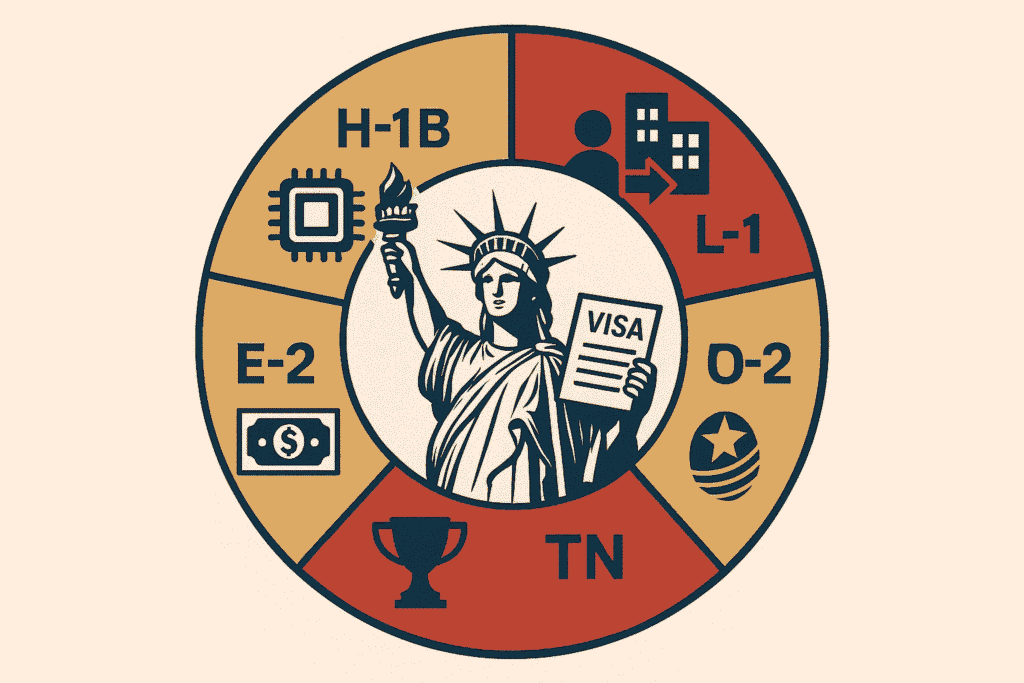
For international professionals seeking jobs in the USA, understanding the various work visa options is crucial to launching a successful American career. The United States offers several visa categories, each with distinct requirements and benefits tailored to different professional situations. Let’s explore these opportunities in detail to help you determine which path aligns best with your qualifications and career aspirations.
H-1B Visa: The Gateway for Specialty Occupation Professionals
The H-1B visa stands as the most sought-after option for skilled foreign workers, particularly in technology, engineering, and healthcare sectors. This visa category requires applicants to meet three fundamental criteria:
First, candidates must possess at least a bachelor’s degree or its equivalent in a field directly related to their prospective job. The U.S. Citizenship and Immigration Services (USCIS) maintains strict standards regarding degree relevance, so applicants should carefully review how their education aligns with their intended position.
Second, a valid job offer from a U.S.-based employer is mandatory. The position must qualify as a “specialty occupation,” meaning it requires specialized knowledge typically obtained through higher education. Common examples include software development, medical research, and architectural design roles.
Third, employers must demonstrate that they will pay the prevailing wage for the position as determined by the Department of Labor. This requirement protects both American workers and visa holders from unfair compensation practices.
The H-1B program operates under an annual cap of 85,000 visas (65,000 for regular applicants and 20,000 for those with advanced degrees from U.S. institutions). This limitation creates intense competition, with applications typically exceeding available visas within days of the filing period opening each April.
L-1 Visa: Facilitating Global Business Transfers
Multinational corporations frequently utilize the L-1 visa to transfer key personnel between international offices and their U.S. operations. This category divides into two distinct classifications:
The L-1A visa serves managers and executives, requiring applicants to demonstrate they will fill senior leadership positions within the U.S. entity. These individuals typically oversee entire departments or make high-level organizational decisions.
For professionals with specialized knowledge about company products, services, or procedures, the L-1B visa offers an alternative pathway. This might include senior engineers with proprietary technical expertise or marketing specialists with unique understanding of international markets.
Unlike the H-1B, the L-1 program imposes no annual numerical limits, and processing times tend to be significantly faster. Many applicants appreciate that this visa category doesn’t require labor certification, streamlining the application process for qualifying candidates.
E-2 Visa: Entrepreneurial Opportunities in America
Aspiring business owners may find the E-2 investor visa an attractive option for establishing operations in the United States. Although the E-2 and the EB-5 immigrant investor program are similar, there are some significant differences:
There’s no fixed minimum investment amount, allowing flexibility based on business type and location. To guarantee successful operation, the investment must be considerable and significant in relation to the overall value of the business. USCIS evaluates investments on a case-by-case basis, considering factors like job creation potential and economic impact.
During their time in the United States, holders of E-2 visas are required to keep their investment intact. and demonstrate that their business generates more than marginal income. This requirement ensures the enterprise contributes meaningfully to the American economy rather than simply supporting the investor’s personal needs.
O-1 Visa: Recognizing Extraordinary Achievement
Those who have excelled in their professions may be eligible for the O-1 visa, which is only granted to people who have demonstrated exceptional talent in the arts, sciences, business, education, or sports. The application process requires extensive documentation proving sustained national or international recognition.
Successful applicants typically provide evidence such as major internationally recognized awards, published material about their work in professional publications, original contributions of major significance to their field, and high compensation relative to others in their profession. Because USCIS seeks candidates who are at the top of their respective disciplines, the bar is extraordinary.
TN Visa: Special Provisions for North American Professionals
The TN visa is available to citizens of Canada and Mexico for specific professional jobs under the United States-Mexico-Canada Agreement (USMCA). This category includes positions like accountants, engineers, scientists, and management consultants, among others listed in the trade agreement.
TN visa holders enjoy very simple application procedures, particularly for Canadian candidates who can frequently apply in person at the U.S. ports of entry. Unlike many other work visas, the TN classification doesn’t require employer sponsorship in the traditional sense, though applicants must still present a job offer from a U.S. employer.
Choosing the Right Visa for Your American Dream
Your professional history, career objectives, and unique situation must all be carefully taken into account while choosing the right visa type. Each option presents unique advantages and limitations that can significantly impact your American experience.
For those curious about which industries currently offer the most opportunities for foreign professionals, our comprehensive analysis on Which Industries Are Hiring the Most in the USA? provides valuable insights into current employment trends and high-demand sectors.
Remember that immigration policies frequently change, and consulting with an experienced immigration attorney can help ensure you pursue the optimal path for your specific situation. With proper preparation and understanding of these visa options, you’ll be well-positioned to navigate the complex but rewarding journey toward working in the United States.
Step-by-Step Process to Get a Work Visa
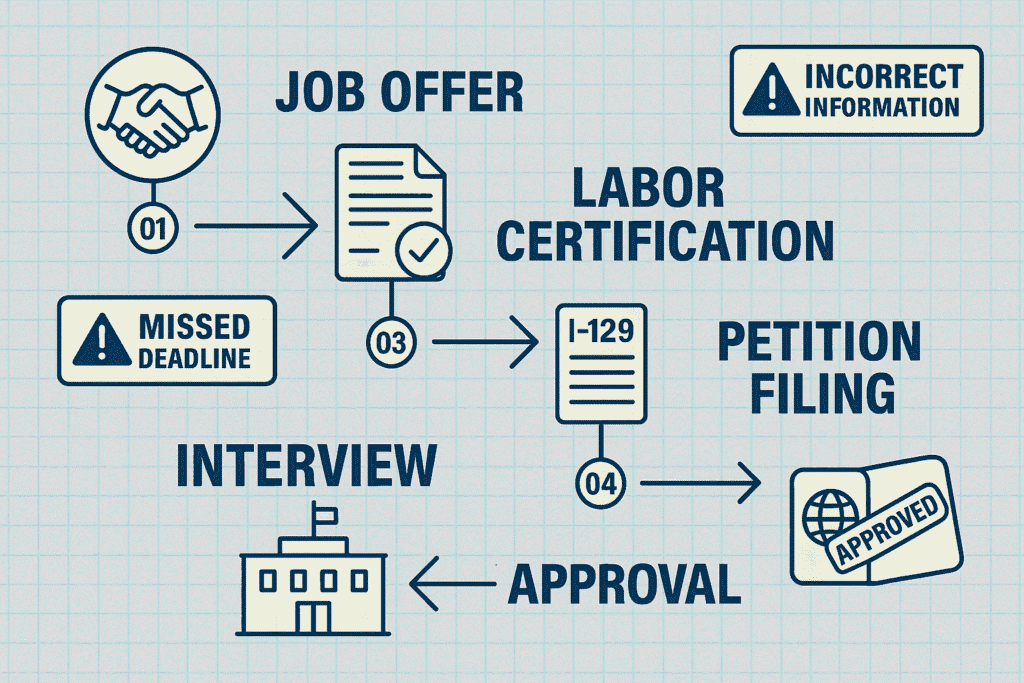
1. Securing Employer Sponsorship: Your First Critical Step
The quest for employer sponsorship represents the most critical—and often most challenging—phase of obtaining a U.S. work visa. Unlike simply landing a job offer, sponsorship requires finding an American employer willing to invest significant time and resources into navigating the complex immigration process on your behalf. This partnership becomes the foundation upon which your entire American career dream rests.
Strategic Targeting: Finding the Right Sponsorship Opportunities
While tech behemoths like Google and Amazon dominate headlines for their extensive visa sponsorship programs, savvy applicants cast a wider net. Many mid-sized companies in high-demand sectors—particularly healthcare, engineering, and specialized manufacturing—actively sponsor foreign talent but receive fewer applications. These hidden gems often offer faster processing times and more personalized attention throughout the visa journey.
Mastering the Sponsorship Job Search
Your job hunt strategy needs careful calibration when sponsorship is required. Begin by optimizing your LinkedIn profile with strategic keywords like “H-1B sponsorship available” and “visa transfer eligible” in your headline and summary. Connect directly with recruiters at target companies, emphasizing how your international background provides unique value they can’t find locally.
Specialized platforms like H1BGrader and MyVisaJobs offer invaluable insights into companies’ historical sponsorship patterns. Cross-reference this data with Department of Labor wage disclosures to identify employers who consistently sponsor at competitive salary levels.
The Art of the Sponsorship Pitch
When approaching potential sponsors, shift the conversation from why you need the visa to how your global perspective solves their business challenges. Prepare concrete examples of how your international experience:
- Brings unique technical skills not readily available in the U.S. market
- Provides cultural competency for companies expanding globally
- Offers specialized knowledge of emerging international markets
- Introduces innovative approaches from other business ecosystems
Building Relationships Before You Need Them
The most successful applicants don’t wait until they need sponsorship to start building connections. Participate in industry conferences (many now offer virtual attendance), contribute to professional forums, and engage with potential employers’ content online. These relationships, cultivated over time, often lead to sponsorship opportunities that never get publicly posted.
Navigating the Sponsorship Conversation
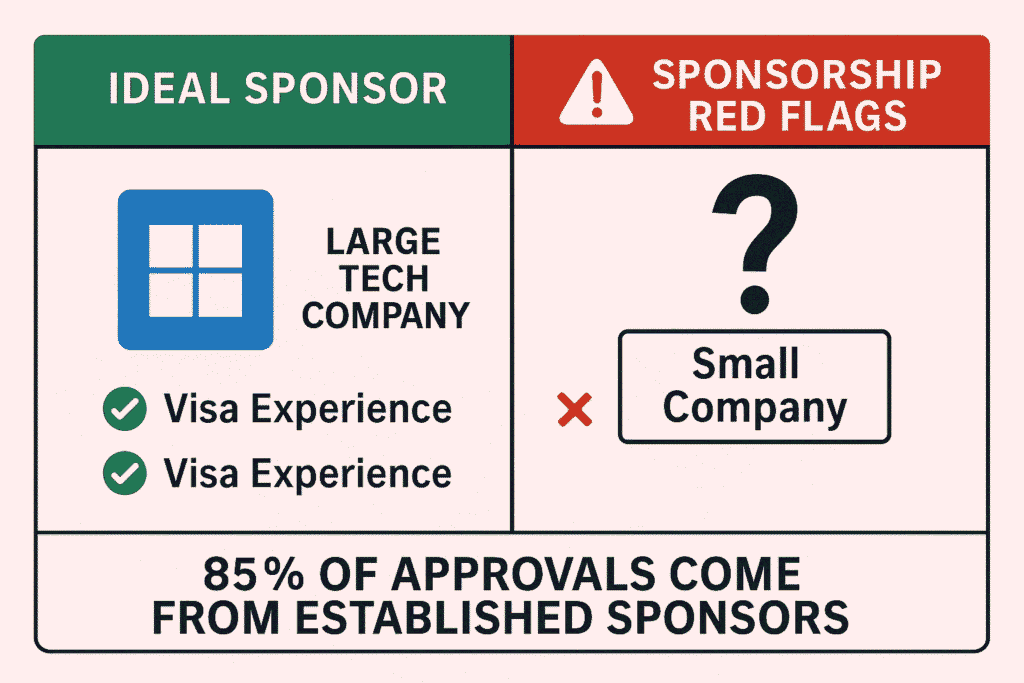
When sponsorship enters the discussion, be prepared to:
- Clearly explain the process requirements and timelines.
- Outline the employer’s responsibilities (petition filing, legal fees, etc.).
- Demonstrate how you’ll add value from day one.
- Provide documentation of your qualifications upfront.
- Offer to connect them with immigration resources if needed.
Remember, companies sponsor visas because it solves their talent needs—your job is to show you’re worth the investment. With the right approach, you can turn sponsorship from an obstacle into your competitive advantage in the U.S. job market.
2. Navigating the PERM Labor Certification Process
The Program Electronic Review Management (PERM) labor certification stands as one of the most critical yet misunderstood steps in obtaining certain employment-based visas like the EB-3. This mandatory procedure serves as the U.S. government’s safeguard to ensure foreign workers aren’t displacing qualified American candidates. For applicants, successfully navigating PERM means clearing one of the most substantial hurdles in the green card process.
The Recruitment Phase: Proving a Genuine Need
Before your employer can even begin the PERM application, they must conduct what’s essentially a “test of the job market” through rigorous recruitment efforts. This isn’t just a formality—the Department of Labor requires documented proof of extensive outreach across multiple channels:
- Job postings on the employer’s website and at least three other major job boards
- Sunday newspaper advertisements in the targeted job location (yep, even in the digital age)
- State workforce agency listings for a minimum of 30 days
- Additional recruitment methods for professional positions, including campus recruiting or trade publications
During this phase, your future employer must carefully evaluate all applicants and document legitimate business reasons for any rejections. Even one misstep in this documentation can result in denial or audit.
Prevailing Wage Determination: Setting Fair Compensation
Concurrent with recruitment, your employer must obtain an official Prevailing Wage Determination (PWD) from the Department of Labor. This isn’t simply looking up salary data—it’s a formal process where:
- The employer submits detailed job descriptions and requirements.
- DOL analysts match the position to specific occupational codes.
- Based on geographic geography, officials establish the minimum salary that is considered appropriate.
This wage floor protects both American workers from being undercut and foreign workers from exploitation. The PWD process alone typically takes 3-5 months, during which recruitment cannot begin.
The Waiting Game: PERM Processing Timelines
Employers send Form ETA 9089 to the Department of Labor once they have finished hiring and putting the application together. Current processing times range from:
- Standard processing: 6-12 months
- Audited applications: 12-18 months (when DOL requests additional evidence)
During this anxious waiting period, maintain open communication with your employer, but understand there’s little anyone can do to accelerate government processing. Many applicants use this time to gather documents for the subsequent I-140 petition.
Common Pitfalls and How to Avoid Them
Even well-prepared PERM applications face challenges:
- Overly specific job requirements may trigger audits.
- Denials result from incomplete documentation during the hiring procedure.
- Wage level disputes can require restarting the process.
- Changing job markets may necessitate new recruitment.
Your best defense? Work with an experienced immigration attorney who can anticipate these issues before they arise. Remember, while PERM requires patience, it’s a necessary step toward establishing your long-term career in the United States.
3. Filing the Visa Petition: Paperwork That Opens Doors
After securing employer sponsorship, you enter one of the most crucial stages of your visa journey: filing the official petition. This paperwork-intensive phase serves as your formal request to the U.S. government for work authorization. The documents you submit now will determine whether your American career dreams become reality or face unexpected delays.
Understanding the Two Primary Pathways
The U.S. immigration system divides work visa petitions into two distinct processes:
Employer-Filed Petitions (I-129)
For H-1B, L-1, and O-1 visa seekers, your employer takes the lead by submitting Form I-129 to USCIS. This comprehensive document requires:
- Detailed information about the petitioning company’s finances and operations
- Evidence of your qualifications matching the position requirements
- Evidence that the firm can afford to pay the wage that is being offered
- Documentation of any required licenses or certifications
Self-Filed Applications (DS-160)
E-2 and TN visa applicants follow a different route, completing the online DS-160 form themselves before scheduling a consular interview. This application demands:
- Complete personal and professional history
- Detailed travel information
- Comprehensive answers about your intended U.S. activities
- Upload of a compliant passport-style photo
The Premium Processing Advantage
While standard processing times can test your patience (often taking several months), USCIS offers an expedited option for certain visa types. For a further $2,500, premium processing ensures:
- A response within 15 calendar days (not necessarily approval)
- Faster adjudication for time-sensitive cases
- The ability to upgrade existing petitions
This option proves particularly valuable when facing tight deadlines or when employers need to fill positions urgently.
Common Documentation Pitfalls to Avoid
Significant delays may result from even small mistakes in your petition:
- Inconsistent dates across different forms
- Mismatched job titles between offer letters and petitions
- Expired supporting documents (keep all certifications current)
- Improperly formatted evidence (follow USCIS guidelines exactly)
Many applicants benefit from creating a master checklist and timeline to ensure all documents remain synchronized throughout the process.
Preparing for the Next Steps
While waiting for petition approval, smart applicants use this time to:
- Research their intended U.S. location.
- Begin gathering documents for the eventual visa interview.
- Stay in regular contact with their employer’s immigration team.
- Monitor processing times through the USCIS Case Status Online portal.
Remember, this paperwork phase represents just one step in your journey. With careful attention to detail and proper preparation, you’ll soon be ready for the final hurdle: your visa interview.
4. The Visa Interview: Your Moment to Shine
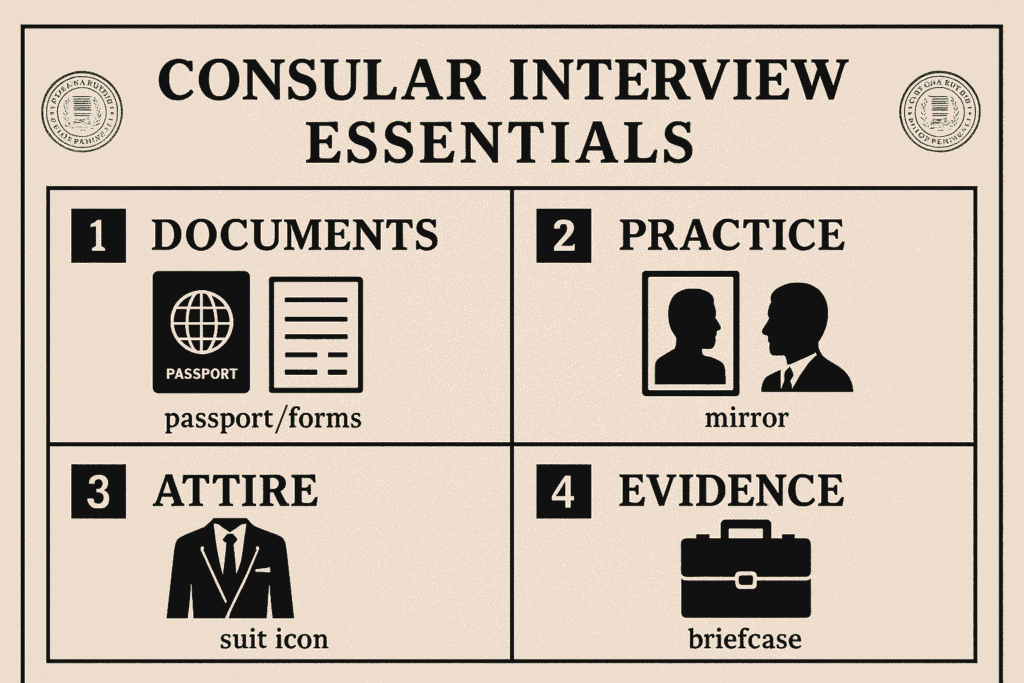
The visa interview isn’t just a formality—it’s your opportunity to personally demonstrate why you qualify for U.S. work authorization. This crucial discussion, which usually lasts only three to five minutes, necessitates careful planning. Consular officers evaluate hundreds of applications daily, so making a strong, authentic impression is crucial to standing out.
Essential Documents: Your Interview Survival Kit
Walking into your interview without the proper documentation is like arriving at a job interview without your resume. Ensure you have:
- Validity of Passport: Your passport must be valid for at least six months after the time you want to visit. Consider bringing previous passports if they show important travel history.
- Approval Notices: For H-1B applicants, the original I-797 approval notice is mandatory. Make clean photocopies as backups.
- Employment Verification: Your job offer letter should include detailed terms—salary, job duties, location, and duration. Bring recent pay stubs if already working for the employer.
- Educational Proof: Original diplomas, transcripts, and professional licenses establish your qualifications. Consider bringing course descriptions if your degree title doesn’t clearly match the job.
- Home Country Ties: Documents like property deeds, family obligations, or future employment contracts help demonstrate your intent to eventually return home.
Anticipating and Practicing Common Questions
During the interview, consular agents usually concentrate on three main areas:
1. Job-Specific Questions
- Describe your daily responsibilities in detail.
- How are you qualified for this position by your training and experience?
- What makes you more qualified than an American applicant?
2. Employer Knowledge
- How did you find this job opportunity?
- What does your company produce/service?
- How many employees work at your location?
3. Future Intentions
- Where will you live in the U.S.?
- What are your long-term career goals?
- What connections keep you in your home country?
Practice answering concisely while standing (some consulates don’t provide seating). To ensure clarity and get rid of worried behaviors, record yourself.
Dress and Demeanor: Making the Right Visual Impression
While there’s no formal dress code, business professional attire projects seriousness. Arrive 30 minutes early to clear security (but not earlier—many consulates deny early entry). Maintain polite eye contact, speak clearly, and keep answers truthful and consistent with your paperwork.
Handling Potential Challenges
If the officer seems skeptical:
- Remain calm and professional.
- Offer additional documentation if asked.
- Avoid arguing with or correcting the officer.
- If denied, politely ask for the specific reason to address in future applications.
Remember, thorough preparation transforms this nerve-wracking experience into an exciting milestone on your path to U.S. employment. With the right documents, practice, and mindset, you’ll walk out with the approval stamp that launches your American career journey.
5. Crossing the Finish Line: Entry and Onboarding
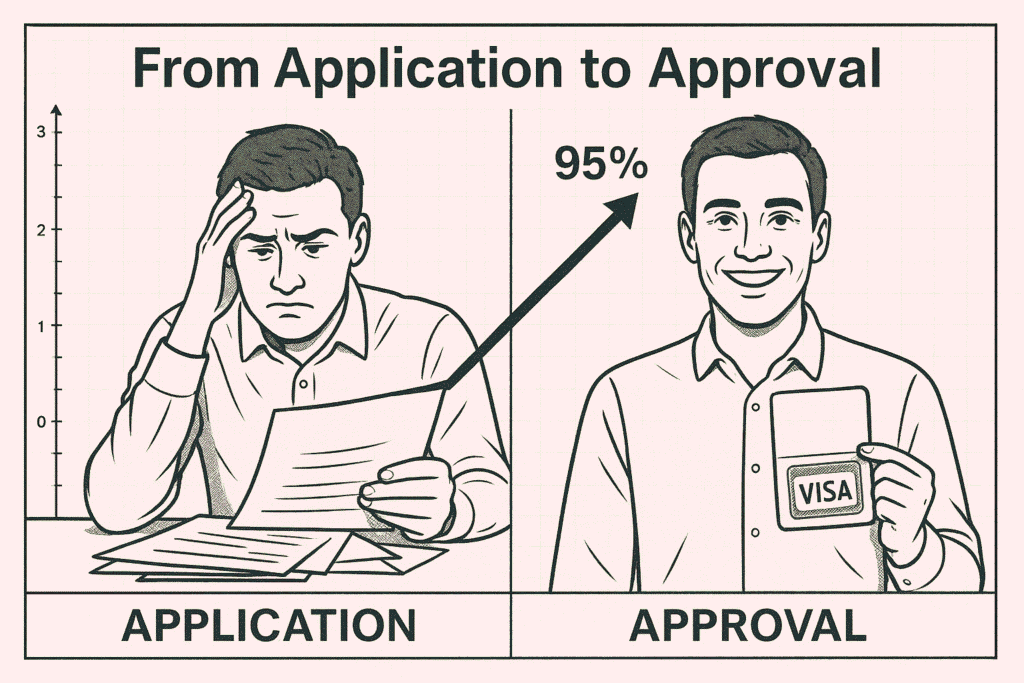
After months of preparation, your first steps on American soil with an approved work visa mark the beginning of an exciting new chapter. As you approach Customs and Border Protection (CBP), remember these key points:
- Present your passport with the visa stamp and your sealed immigration packet (if applicable).
- Be prepared to briefly explain your work purpose in the U.S.
- Verify your I-94 arrival record online within 72 hours (https://i94.cbp.dhs.gov).
- Keep all entry documents in a secure folder—you’ll need them for onboarding.
CBP officers may direct you to secondary inspection for additional verification. This routine process allows them to confirm your visa details and employment information.
Essential Administrative Tasks for Your First 30 Days
1. Securing Your Social Security Number (SSN)
Your SSN serves as your financial identity in America. Visit your local Social Security Administration office with:
- Passport with visa stamp
- I-94 arrival record
- Completed SS-5 form
- Job offer letter
Processing typically takes 2-4 weeks. Many employers will let you start work while waiting, but you’ll need it for payroll setup.
2. Completing Employer Onboarding
Corporate onboarding often includes:
- Form I-9 employment eligibility verification
- Benefits enrollment (health insurance, retirement plans)
- Company-specific training programs
- Equipment setup and workspace orientation
3. Establishing Financial Foundations
Open a U.S. bank account with:
- Passport
- SSN or proof of application
- Proof of U.S. address
- Initial deposit
Consider accounts with international transfer capabilities and low foreign transaction fees.
4. Obtaining State Identification
Visit your local DMV to get either:
- State ID card (for non-drivers)
- Driver’s license (after passing written and road tests)
Required documents typically include:
- Passport with visa
- I-94 record
- Proof of residence (lease/utility bill)
- SSN
Creating Your American Home Base
Finding housing involves important considerations:
- Short-term corporate housing helps with initial transition.
- Rental applications require credit history—be prepared with extra deposits.
- Understand tenant rights in your state.
- Consider proximity to work and public transportation.
Many newcomers benefit from temporary furnished apartments while learning neighborhoods and commuting patterns.
Building Your Support Network
Smart strategies for settling in:
- Connect with expat communities through platforms like Meetup.
- Explore professional associations in your field.
- Establish care providers (doctor, dentist).
- Learn about local international grocery stores.
Remember, while employers often provide relocation assistance, taking initiative in these early weeks demonstrates professionalism and helps you feel at home faster. Each completed task brings you closer to fully focusing on your exciting new career opportunity in the United States.
Pro Tip: Avoiding Common Pitfalls
Even with perfect preparation, applicants often stumble on small but critical details:
- Ensure all documents use consistent name spellings.
- Verify petition filing dates and deadlines.
- Double-check that your passport won’t expire during your intended stay.
- Maintain copies of every submitted document.
By methodically following these steps while remaining adaptable to unexpected challenges, you’ll maximize your chances of successfully obtaining your U.S. work visa and beginning an exciting new professional chapter.
Job Market Trends Affecting Work Visas
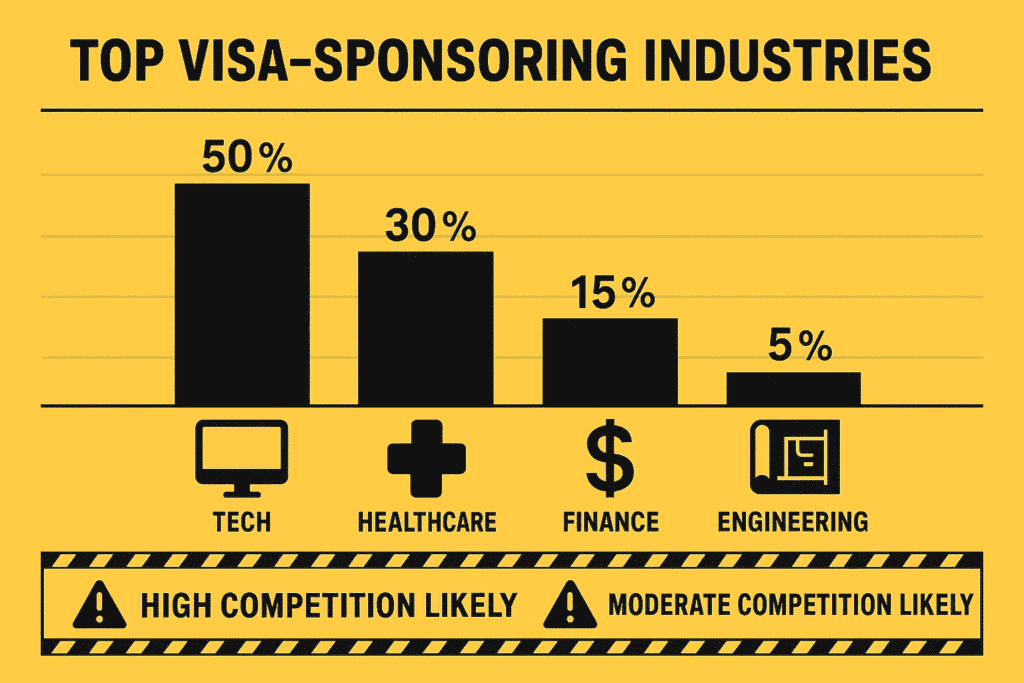
The American job market continues to evolve, creating exciting opportunities for skilled foreign professionals while simultaneously reshaping visa sponsorship trends. Understanding these dynamics can significantly improve your chances of securing employment and work authorization in the United States.
Technology Sector Dominates Visa Sponsorship
There are no indications that Silicon Valley’s ravenous demand for the best tech personnel will abate. Software engineers, particularly those specializing in artificial intelligence, cloud computing, and cybersecurity, remain the most sought-after professionals for H-1B visas. Major tech hubs like Austin, Seattle, and Boston are competing fiercely for these specialists, with many companies offering premium compensation packages and expedited visa processing to attract the best candidates.
The data science field has emerged as another hotspot, with U.S. employers sponsoring 28% more visas for data professionals in 2023 compared to previous years. This surge reflects the growing importance of big data analytics across industries ranging from healthcare to finance.
Healthcare Industry Faces Critical Shortages
America’s healthcare system continues to experience severe staffing shortages, creating unprecedented opportunities for foreign medical professionals. The EB-2 and EB-3 visa categories have become crucial pipelines for hospitals and clinics seeking qualified physicians, nurses, and medical researchers.
Rural healthcare facilities are particularly active in sponsoring international staff, often offering faster visa processing and additional benefits like housing allowances. Specialized medical fields such as geriatric care, oncology, and psychiatry currently show the highest demand for foreign-trained professionals.
Financial Services Adapt to Global Talent Needs
Wall Street and major consulting firms have refined their approach to international hiring, with L-1 intracompany transfers becoming increasingly strategic. Many financial institutions now establish “rotation programs” that bring foreign specialists to U.S. offices for 2-3 year periods, combining knowledge transfer with career development opportunities.
Fintech startups have emerged as surprising contenders in visa sponsorship, with many leveraging the O-1 visa for exceptional talent in blockchain development and quantitative analysis. This represents a significant shift from traditional finance’s reliance on H-1B and L-1 options.
The Remote Work Revolution and Its Visa Implications
The global shift toward remote and hybrid work models has created both opportunities and challenges for foreign professionals seeking U.S. employment:
Physical Presence Requirements Remain Firm
Despite the proliferation of remote work, U.S. immigration law maintains strict physical presence requirements for work visa holders. This means that while American companies may hire remote workers abroad without visa sponsorship, those seeking to live and work in the United States must still obtain traditional work authorization.
Emerging Hybrid Models
Some forward-thinking companies are experimenting with “blended” arrangements where employees begin working remotely from their home countries while visa applications process, then transition to U.S.-based work upon approval. This approach can significantly reduce the financial strain of relocation while maintaining compliance.
Future Policy Considerations
Potential reforms to adapt to the new work reality are anticipated by immigration specialists. Concepts like “digital nomad visas” or flexible hybrid work authorizations have gained traction in policy discussions, though substantial changes remain unlikely in the immediate future.
Strategic Insights for Visa Applicants
Understanding these market trends allows foreign professionals to:
- Target industries with the highest sponsorship rates.
- Align skills with current employer demands
- Anticipate processing timelines based on sector priorities.
- Position themselves competitively in the visa application process
As the U.S. labor market continues to evolve, staying informed about these trends will remain crucial for any international professional pursuing American career opportunities. The key lies in matching your unique qualifications with industries demonstrating both immediate need and long-term growth potential in visa sponsorship.
Common Challenges & How to Overcome Them
Facing a visa rejection can feel devastating after months of preparation, but understanding the common pitfalls can significantly improve your chances of approval. The U.S. immigration system is notoriously particular about documentation, and even minor oversights can lead to disappointing outcomes.
One of the most frequent reasons for denial involves insufficient proof of specialty occupation qualifications. For H-1B applicants, this means your employer must clearly demonstrate that the position requires specialized knowledge typically obtained through a bachelor’s degree or higher in a specific field. A common mistake is submitting generic job descriptions rather than tailored explanations of how your unique expertise matches the role’s requirements.
Incomplete applications represent another major hurdle. Missing signatures, expired documents, or inconsistent information across forms can trigger automatic rejections. I’ve seen cases where something as simple as using a nickname on one form while the passport shows a full name created unnecessary complications.
Proven Strategies for Success:
- Work with an experienced immigration attorney who can spot potential red flags.
- Create a comprehensive checklist for all required documents.
- Request a detailed denial explanation if rejected (Form I-292).
- Consider refiling with additional evidence rather than appealing in many cases.
The Waiting Game: Managing Visa Processing Delays
In our fast-paced world, the U.S. immigration system often moves at what feels like glacial speed. Standard processing times for H-1B visas can stretch 5-7 months, while L-1 visas may take 3-5 months. These timelines become particularly stressful when you’re trying to coordinate international moves or start dates with employers.
The USCIS Premium Processing service offers a valuable solution for those who can afford the $2,500 fee. This option guarantees a 15-calendar-day response (not approval) for eligible petitions. For many professionals, this investment proves worthwhile when considering the potential salary and opportunity costs of extended waiting periods.
Alternative Approaches to Consider:
- Monitor USCIS processing times weekly as they fluctuate by service center.
- Explore concurrent filing options where available.
- Maintain open communication with your employer about potential start date adjustments.
- Consider applying from outside the U.S. if consular processing is faster in your country.
Building Resilience in Your Visa Journey
The emotional toll of visa uncertainties shouldn’t be underestimated. Many qualified professionals experience anxiety, frustration, and even career paralysis during the process. Creating coping mechanisms is as crucial as getting your documentation ready.
Successful applicants often:
- Create contingency plans for various outcomes.
- Stay professionally active during waiting periods.
- Build support networks with others going through similar processes.
- Focus on aspects within their control rather than system delays.
Remember that persistence pays off in U.S. immigration matters. Many of today’s successful foreign professionals in America faced multiple rejections or delays before ultimately achieving their goals. Each challenge overcome makes you more knowledgeable and better prepared for the next step in your American career journey.
Alternatives If You Don’t Qualify for a Work Visa
For many aspiring professionals, the F-1 student visa serves as an effective springboard into the American job market. This pathway begins with enrollment in an accredited U.S. educational institution, but the real career potential emerges through the Optional Practical Training (OPT) program.
After earning their degree, international students can participate in OPT for up to 12 months (or 36 months for STEM graduates) to obtain worthwhile job experience. What makes this option particularly attractive is that it doesn’t require employer sponsorship initially—you can work for any company in your field of study. Many savvy students use this period to prove their value to employers, making the transition to H-1B sponsorship much smoother.
Key advantages of this approach include:
- Access to high-quality U.S. education that enhances your professional profile
- Time to build an American professional network
- Opportunity to demonstrate your skills to potential sponsors
- Possibility of receiving curricular practical training (CPT) while pursuing your education
Employment-Based Green Cards: A Direct Path to Permanent Residency
When temporary work visas seem out of reach, the employment-based green card system offers alternative routes to establishing your career in America. The EB-2 and EB-3 categories are particularly relevant for skilled professionals:
EB-2 Visas cater to professionals holding advanced degrees (master’s or higher) or those with exceptional ability in their field. This category often has shorter wait times than EB-3 and may qualify for National Interest Waivers in certain cases, bypassing the usual labor certification requirement.
EB-3 visas serve skilled workers with at least two years of experience or training, as well as professionals with bachelor’s degrees. While processing times can be longer, this remains a viable option for many qualified applicants.
The green card process, while more complex than temporary visas, provides significant long-term benefits:
- No need for visa renewals or status changes
- Freedom to change employers without sponsorship concerns
- Pathway to U.S. citizenship after meeting residency requirements
- Ability to sponsor family members
Creative Alternatives Worth Considering
Beyond these primary options, several less common but potentially viable alternatives exist:
- O-1A Visas for people with exceptional talent in sports, science, or business
- E-2 Investor Visas for entrepreneurs willing to make substantial business investments
- L-1 Visas for executives transferring to U.S. branches of multinational companies
- TN Status for Canadian and Mexican professionals in qualifying occupations
Each of these options has specific requirements and limitations, but they demonstrate that multiple pathways exist for determined professionals seeking to build their careers in the United States. The key is carefully assessing which option best aligns with your qualifications, experience, and long-term goals.
Conclusion
Navigating the complex landscape of U.S. work visas requires equal parts preparation, patience, and perseverance. As we’ve explored throughout this guide, the process demands careful strategic planning from the initial research phase through to your eventual arrival in the United States. The most successful applicants approach their visa journey as a marathon rather than a sprint, understanding that each step builds toward their ultimate goal of establishing a rewarding career in America.
Key Takeaways for Visa Success
Your chances of approval increase dramatically when you:
- Align your qualifications with the specific requirements of your chosen visa category.
- Cultivate strong employer relationships with companies experienced in sponsorship.
- Maintain meticulous documentation throughout the entire application process.
- Stay informed about changing immigration policies and job market trends.
- Prepare thoroughly for each stage, especially the crucial consular interview.
Turning Challenges Into Opportunities
Even while the process might appear difficult, keep in mind that thousands of foreign professionals successfully complete it every year. The temporary hurdles—whether processing delays, paperwork complications, or the emotional strain of waiting—ultimately give way to new career possibilities for those who persist. Many current visa holders will tell you that the challenges they overcame made their eventual success even more rewarding.
Your American Career Awaits
As you move forward with your visa application, keep your long-term professional goals clearly in focus. The effort you invest now in understanding the process, preparing your materials, and building relationships with potential employers will pay dividends throughout your American career journey. Whether you’re pursuing opportunities in Silicon Valley’s tech scene, New York’s financial district, or healthcare institutions across the country, your skills and determination can open doors to remarkable professional growth.
The United States continues to welcome talented professionals who bring valuable skills to its workforce. By approaching the visa process with thorough preparation and realistic expectations, you position yourself to join the vibrant community of international professionals who’ve successfully built fulfilling careers in America. Your journey starts with that first carefully prepared application—where will it take you?
FAQs

1. What’s the typical processing time for different work visas?
Based on the type of visa and the volume of work being done by USCIS, processing periods can vary greatly. For H-1B visas, standard processing takes 3-6 months, though entering the annual lottery can add several months of waiting. The L-1 visa typically processes faster, often within 1-3 months, especially if using premium processing. Always check current USCIS processing times, as these can fluctuate.
2. Can I switch jobs while on an H-1B visa?
Yes, but the process requires careful handling. Before you transition, your new employer needs to submit a fresh H-1B petition. The good news? After USCIS receives the petition, you can begin working for the new company (a process known as “porting”). Your status is still linked to the initial petition, though, until it is approved.
3. What happens if my H-1B visa expires?
You have sixty days to leave the United States, change your status, or find a new job. Some applicants extend their stay by transitioning to a dependent visa (like H-4) or applying for a green card if eligible.
4. Can my family join me in the U.S. on a work visa?
Most work visas allow dependents (spouse and children under 21) to accompany you. H-1B holders can bring family on H-4 visas, while L-1 visa holders use L-2 visas. Some dependent visas even permit work authorization in certain cases.
5. What’s the difference between H-1B and EB-3 visas?
The H-1B is a temporary work visa (3-6 years), while the EB-3 leads to a green card (permanent residency). The EB-3 requires labor certification proving no qualified U.S. workers are available, making the process longer but offering permanent status.
6. How can I check my visa status during processing?
Utilize your receipt number to access the USCIS Case Status Online service. For consular processing, track via the CEAC website. Sign up for case updates to receive email/text notifications about your petition’s progress.
7. What are the main reasons for visa denials?
Common refusal reasons include:
- Insufficient proof of specialty occupation qualifications
- Incomplete or inconsistent documentation
- Failure to meet wage requirements
- Missing deadlines or filing errors
8. Can I apply for multiple visa types simultaneously?
Yes, you can pursue multiple pathways if eligible. For example, someone might have both an H-1B petition and an EB-2 green card application in process. However, each requires separate filings and fees.
9. What happens if I lose my job on a work visa?
Most work visas provide a 60-day grace period after employment termination. Use this time to either find a new sponsor, change visa status, or make arrangements to depart. Some professionals transition to a B-1/B-2 visitor status while seeking new opportunities.
10. How does premium processing work?
Premium processing, which costs an extra $2,500, ensures that USCIS will:
- Issue an approval/denial/RFE within 15 calendar days.
- Provide faster adjudication for eligible visas (H-1B, L-1, O-1, etc.).
This doesn’t increase approval odds but significantly reduces waiting time.
11. Can I start a business on a work visa?
Most work visas don’t permit self-employment. However, the E-2 investor visa allows running a business if you make a substantial investment. Some professionals eventually transition from H-1B to E-2 status.
12. What’s the difference between consular processing and change of status?
Consular processing means applying at a U.S. embassy abroad, while change of status adjusts your visa within the U.S. The right choice depends on your current location and visa type.
13. How long can I stay on an L-1 visa?
L-1B (specialist knowledge) allows five years, whereas L-1A (managers/executives) allows a maximum of seven. Time limits include all extensions.
14. Can I apply for a green card while on a work visa?
Yes! Many professionals begin the green card process while on H-1B or L-1 visas. The PERM labor certification can start after one year on H-1B status in most cases.
15. What should I do if my visa is about to expire?
Before expiration, explore:
- Visa extension filings (if eligible)
- Status change options (like H-1B to H-4)
- Green card applications if qualified
To prevent fines for unauthorized presence, always get legal advice from an immigration attorney prior to the expiration of your status.

